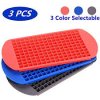Dimner
Named Man
Quick question for you guys. I need to get my CWW bullets harder using the heat treat process.
However, even if the question is quick, the background info necessary will take some explaining. So here is the process and my objectives to give a better picture of what is going on.
The objective is to get at least 2MOA accuracy at 100 yards with my 16" mid length AR-15. I have some specialized components so it will cycle at lower pressures than a normal mid-length system. Cycling isn't really an issue right now. I'm getting good cycling with powders with burn rates ranging from H4198 up to Varget. So far the most accurate has been Shooters World Match Rifle and H4895 (they are pretty much the same burn rate)
I am currently at around 3MOA with these loads, but they are leading the barrel to the point where around 30+ loads open up groups to 4-5MOA. Barrel slugs to 0.224. Currently I suspect my bullets are not hard enough for the ~2050-2150 fps I am shooting these at.
So back to the quick question:
However, even if the question is quick, the background info necessary will take some explaining. So here is the process and my objectives to give a better picture of what is going on.
The objective is to get at least 2MOA accuracy at 100 yards with my 16" mid length AR-15. I have some specialized components so it will cycle at lower pressures than a normal mid-length system. Cycling isn't really an issue right now. I'm getting good cycling with powders with burn rates ranging from H4198 up to Varget. So far the most accurate has been Shooters World Match Rifle and H4895 (they are pretty much the same burn rate)
I am currently at around 3MOA with these loads, but they are leading the barrel to the point where around 30+ loads open up groups to 4-5MOA. Barrel slugs to 0.224. Currently I suspect my bullets are not hard enough for the ~2050-2150 fps I am shooting these at.
- I'm working with MP molds 75 grain heavy nato bullet gas checked. https://www.mp-molds.com/product/mp-227-75-gc-nato-6-cav/
- I am casting using straight clip on wheel weights. Air cooled from the mold
- Gas checked and sized to 0.226
- Powder coated using Smoke's Ford Blue and Bacon Grease (kind of a custard yellow) - Using a convection toaster @400 degrees for around 20-22 minutes. Air cooled after removal.
- No additional sizing after the powder coating process.
- Bullets pass the hammer test.
- After around 8 hours, or a day later (basically when I am confident the bullets are at room temperature)
- Heat treating using the convection toaster at 425 degrees for 1 hour.
- Toaster oven shows 425 degrees, but my TEL-TRU shows 415-420 degrees.
- After an hour, immediate quench in ice cold water
- Probably sits in the ice water around 5 minutes. I make sure the water remains ice cold.
- 7 days post heat treat, I file a flat portion of the bullet and check the hardness. I'm getting 11.8 - 14.3 BHN.
- Oddly enough, bullets that I have not heat treated, but only PCed on 400 for 20 minutes and quenched in ice water measure at around 15.0 BHN.
- This is using the Lee hardness tester. It's not perfect, but I did test a bunch of non-PC non-Heat treated bullets that I cast a year ago and let air cool from the mold, those are testing at around 11-12 BHN. So even if my #'s are not spot on, the difference in BHN should be much greater with my heat treated bullets.
So back to the quick question:
- Why are my bullets not hardening to the point I'm expecting (18-22bhn). Since these are 22cal bullets, I thought I had the temp/time of heat treat adjusted correctly.
- I dont have the time currently to do the full blown hardness testing array of different temps and days let set after heat treat.
- So with that, given my current setup, what variable would you change to get a harder bullet? I'd rather not change the alloy as the only other thing I have on hand is a small amount of tin and pure lead. I do not have any lino, or hard type leads.


